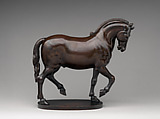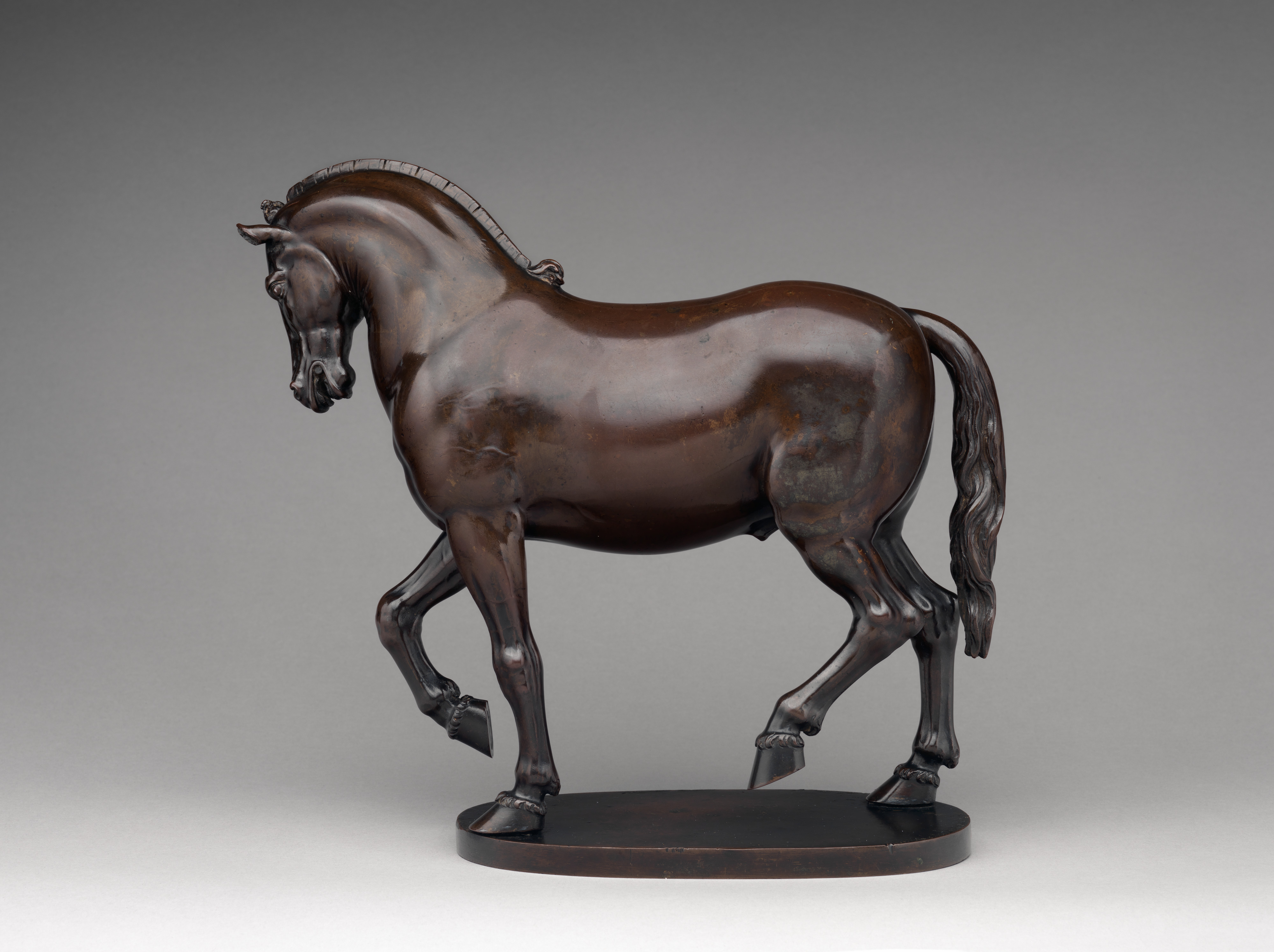Trotting horse
After a model by Giambologna Netherlandish
Once part of the collection of English aristocrat Charles Bowyer, the Trotting Horse entered The Met in 1924 with the Ogden Mills bequest of twenty-five Italian Renaissance bronzes that included four pacing or rearing steeds.[1] Noting the high quality of the horses, curator Joseph Breck otherwise offered no specific attribution. It is thanks to the work of Katharine Watson and Charles Avery, beginning in 1978, that the present bronze eventually received greater critical focus, tracing its production to Giambologna’s workshop. In its pose, dimensions, and treatment of details, The Met horse can be linked to an important lineage of bronzes associated with the Flemish master. This group includes an autograph statuette in the Bargello (fig. 118a) that was recorded in the Medici collections (Casino di San Marco) from 1588.[2] However, unlike our horse, whose sleek anatomy is free of adornment, the Florentine statuette has a saddle cloth on its back, a sheath on its tail, and in its mouth a simple bit with thin shanks.[3] Other Giambologna horses, inserted into more complex narrative compositions, are comparable with ours: the chargers in the reliefs of Christ on the Road to Calvary (Palazzo dell Università, Genoa) and Cosimo I’s Entrance into Siena (Piazza della Signoria, Florence), the former made in 1585–87 for the Grimaldi chapel in San Francesco di Casteletto, the latter in 1598 for the base of the large equestrian statue of Cosimo I.[4]
Giambologna’s dedication to meeting (or creating) market demand for his small equestrian bronzes is well documented, going back to at least 1563. That year, in a letter of January 15, the sculptor informed Francesco I of a new horse model, height “due braccia” (ca. 116 cm), that he wished to bring to the attention of the Medici family. In 1568, Cosimo Bartoli wrote to Giorgio Vasari from Venice that he had received “a horse of the Flemish artist and then another smaller one,” both of which were cast in bronze. Between February 1573 and April 1579, the account books of the Salviati family show payments to Girolamo di Zanobi Portigiani and Battista Lorenzi for making “the core . . . of the little horse of Giambologna,” and for casting and cleaning it per the order of Jacopo Salviati.[5] There is evidence to suggest that in September 1582, the same Portigiani sent Antonio Susini two horses for Giambologna, perhaps for finishing after they came back from the foundry.[6] Later, in the winter of 1587 and summer of 1588, Susini may have been paid for seven small models of horses in yellow wax at the same time Giambologna’s workshop—in which Susini was a constant presence—was busy with the design for the monument of Cosimo I.[7]
Our bronze horse appears in the posthumous inventory of the estate of Lorenzo Salviati, as the work of Susini; another one was cast by Pietro Tacca as part of a gift sent by Cosimo II to Henry, prince of Wales in 1612.[8] Similar statuettes are documented in the Low Countries during the seventeenth century in the collections of Nicolaas C. Cheeus, Cornelis van der Geest, and Jan van Meurs.[9] Moreover, in the list of Giambologna’s creations in bronze compiled in 1688 by Filippo Baldinucci, there is mention of “the little horse standing on two feet” and “the other walking horse,” confirming the fine-tuning of two different pensieri that found fortune as replicas and variants.[10]
These generic annotations do not permit precise identification with specific works or prototypes. For this reason, some weight can be accorded visual evidence such as a portrait of Bernardo Vecchietti, recently brought to light by Francesca Carrara, in which the generous patron of the young Giambologna is depicted with a small gilt bronze horse (fig. 118b).[11] This painting may well be a copy of a much older portrait executed at Vecchietti’s behest. Indeed, the Serie degli uomini più illustri di Firenze, a compilation of biographies written in the eighteenth century, tells us that Giambologna made a bronze horse for Vecchietti, who in turn commissioned a portrait of himself from Santi di Tito that included this same horse displayed on a table. According to the Serie, the horse was subsequently acquired by English aristocrat William Lock of Norbury Park.[12] The critical point here is that the animal as depicted by the painter is bareback, has a neatly trimmed mane, and stands on an oval base, a combination of features shared with The Met bronze. Although it is not possible to draw a continuous line of ownership between our sculpture and Vecchietti’s,[13] it is nonetheless significant that the painting demonstrates the existence of a Giambolognesque invenzione in the second half of the sixteenth century that we find today only in our statuette.
Richard Stone’s technical analysis of the casting technique adopted for the Trotting Horse places its provenance firmly in the sixteenth century in Giambologna’s workshop. The metal alloy, consisting of a moderately leaded tin bronze, corresponds to that found in other Giambologna bronzes, along with the wax-to-wax join at the base of the neck, with a short length of wire traversing the join, visible in radiographs. Even the translucent warm brown patina is “absolutely typical.”[14] Radiographs identify an unusual feature: an iron armature that extends up from the belly and makes a sudden bend to horizontal, terminating over the horse’s forelegs. The sheared-off square-sectioned end of the bar is just visible under the patina on the horse’s belly. Core pin holes were plugged with bronze wires, as opposed to the threaded screw plugs that are typically found on later Giambologna bronzes, supporting an early date for the cast.[15]
The thin oval base is also consistent with Giambologna’s workshop practices. Such a base is found, for example, on the Bull and Lion recorded at the Casino di San Marco from 1588 as works of the master (now in the Bargello); likewise the signed Nessus and Dejanira in Dresden.[16] Walking horses with an analogous base include the Bargello bronze illustrated here and one in the Hill collection.[17] The anchorage on the underside of our horse’s base (fig. 118c) is the same as that used in other Giambologna bronzes. Visible on the flat support are thicker areas in which two holes were made to hold the casting sprues that extended from the soles of the horse’s hooves. Once inserted into these cavities, the sprues’ protruding rods were shaved off and hammered, to flatten the metal across the top.[18]
Despite some wear, the sensitive anatomical treatment can be seen in the legs (shanks and hocks), pectoral muscles, and chin furrow. The less skillfully worked parts—the tail attachment, the forehead between forelock and muzzle—correspond to those areas of the composition where tack would be added. We can thus surmise a sequence of invenzioni that begins with the prototype for The Met horse and progresses to that of the Bargello cast. In fact, the first pensiero behind our bronze might be considered a study of form on which to successively build—perhaps in another model—the riding equipment. The notion of such a development is supported by the fact that here the only element of the bit depicted is the mullen held between the horse’s jaw and tongue.
Michael Bury, in a study dedicated to Vecchietti, proposed that the patron’s bronze horse be dated “before the late 1570s,” like the model in wood of Julius Caesar brought to light in 1978.[19] Both Avery and Carrara argue that the bronze must date to around 1563.[20] An early dating for the prototype thus appears nearly unanimous and points to The Met bronze being the fruit of a quite early cast, which can be placed in the last decades of the sixteenth century. This early dating would explain the use of an oval base and the statuette’s exceptional quality.
An echo of this invenzione—several variants removed from the model—can be found in the pacing stallion formerly in the Robert H. Smith collection and attributed to Barthélemy Prieur.[21]
-TM
Footnotes
(For key to shortened references see bibliography in Allen, Italian Renaissance and Baroque Bronzes in The Metropolitan Museum of Art. NY: The Metropolitan Museum of Art, 2022.)
1. Bowyer loaned a “Cinque Cento Italian Bronze Horse” to the National Exhibition of Works of Art in Leeds in 1868 (Leeds 1868, p. 204, cat. 799). However, given the generic catalogue description, it is impossible to establish which of the bronze horses in his collection was displayed (see also cat. 119B).
2. Dimitrios Zikos in Paolozzi Strozzi and Zikos 2006, p. 275, cat. 60.
3. These details also appear on other bronze horses attributed to Giambologna’s workshop: Kunsthistorisches Museum, KK 5839; Clark Art Institute, Williamstown, Mass., 1955.1004; Nationalmuseum, Stockholm, NMSk 346; Ashmolean, WA1899.CDEF.B445; Hill collection (Wengraf 2014, pp. 126–35, cat. 7).
4. Wengraf 2014, p. 132.
5. “il cavallo del Fiamingo et poi un altro minore”; “haver fatto l’anima . . . al Cavallino di Giambologna”; “messer Iacopo.” Utz 1973, pp. 40, 68–69, docs. 2, 3, 6–8, 13, 14.
6. Zikos 2013, pp. 198, 208 n. 27.
7. Ibid., pp. 198, 208 n. 29.
8. Watson and Avery 1973, pp. 504–5, docs. I, VII.
9. Wengraf 2014, p. 132.
10. “il cavallino che sta in su due piedi”; “l’altro cavallo camminante.” Baldinucci 1681–1728, vol. 2, p. 136.
11. Carrara 2006, pp. 308–9.
12. Serie 1769–75, vol. 7, p. 30 n. 3: “Il medesimo cavaliere inglese possiede un elegantissimo Cavallino di bronzo, che Giovan Bologna condusse all’ultima perfezione per farne dono al detto Bernardo Vecchietti, quale per segno della stima, che egli aveva ve lo fece dipingere appresso sopra il suo tavolino da’ Santi di Tito in occasione di farsi fare il Ritratto” (The same English gentleman [Lock] owns a very elegant little horse in bronze that Giambologna made perfectly to give as a gift to Bernardo Vecchietti, who, as a sign of his admiration, had it painted on a little table in his portrait by Santi di Tito). Lock’s horse and Santi’s portrait are also mentioned in Vasari 1767–72, vol. 7, p. 171 n. 1. For the collection history of Lock’s horse, see C. Avery 2000, p. 15.
13. Proposed by C. Avery 2017a, p. 34.
14. Stone 2010, p. 112.
15. R. Stone/TR, November 16, 2010.
16. For the Bull and Lion, see Wengraf 2014, pp. 122–23, 125 n. 52; for the Nessus and Dejanira (Staatliche Museen, Dresden, H2 3/95), see C. Avery 2017a, p. 33, fig. 22.
17. See note 3.
18. Wengraf 2014, pp. 122–23.
19. Bury 1985, p. 26; C. Avery 2017a.
20. C. Avery 2000, p. 15; Carrara 2006, p. 308; C. Avery 2017a, p. 33.
21. Fabio Barry in Radcliffe and Penny 2004, pp. 226–29, no. 40.
Due to rights restrictions, this image cannot be enlarged, viewed at full screen, or downloaded.
This artwork is meant to be viewed from right to left. Scroll left to view more.




